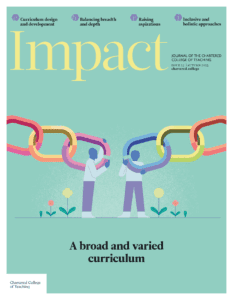How long is a piece of string? Balancing a broad and varied curriculum in teacher and leader professional development

KYLE BAILEY, TEACHING SCHOOL HUB LEAD, BIRMINGHAM SOUTH; STAR ACADEMIES, UK
PETE GANDON, HEAD OF PROGRAMMES, SOUTH AND WEST; NATIONAL INSTITUTE OF TEACHING, UK
ADELE FLETCHER, ITTInitial teacher training - the period of academic study and time in school leading to Qualified Teacher Status (QTS) TUTOR, SOUTH AND WEST; NATIONAL INSTITUTE OF TEACHING, UK
How long is a piece of string? Could this refrain be applied to teacher development when thinking about the content for teachers and leaders? The ‘length of the string’ – the time that it takes for a teacher or leader to master elements of practice – should have direct implications for the decisions that teacher educators make in schools, universities and other educational settings.
With a vast amount of material to cover and limited time in which to cover it, a deep understanding of how teachers and leaders best develop is essential. As David Berliner suggested back in 1988, ‘we probably need to think through the scope and sequence of teacher education experiences in the same way and with the same care that we develop scope and sequence guides for students from kindergarten to twelfth grade’ (p. 26). Most elements of teacher development won’t be mastered in a single staff twilight professional development session.
In this article, we will outline the need for teacher educators to carefully consider each element of practice, their interdependence and sequence. The craft of constructing a coherent curriculum sequence requires teacher educators to bear in mind the ‘length of each piece of string’.
Challenges in teacher development
Just like students in a classroom, teachers and leaders face a number of challenges in their learning and development. These challenges directly influence the ‘length of the piece of string’, and even when educators attend to what we would like, it is difficult to ensure lasting learning, sometimes for these reasons:
- People forget
- People misunderstand
- We are dealing with people, not robots
- Some content is more difficult in nature
- Areas for development are poorly defined
- Habit formation takes time.
People forget
It is not the aim of this piece to go through what is known about the difficulties in learning versus performance generally, but Bjork and Bjork (2023, p. 19) provide a helpful summary, including some key details related to forgetting and the role of memory:
“(a) current performance is not a reliable index of learning, which can only be measured by recall after a delay
(b) forgetting – rather than being the enemy of learning or a process that tears down what learning has built up – is a process that can provide opportunities for enhanced learning, thus serving an important role in the adaptive system of human learning and memory
(c) we cannot trust our instincts as to how best to optimise study and practice; indeed, to optimise learning and instruction often requires going against one’s intuitions
d) using one’s memory changes one’s memory, both by making retrieved information more recallable than it would have been otherwise… and by making information in competition with the retrieved information less recallable in the future.”
Teacher educators must therefore consider carefully how and when learning can be revisited and think about opportunities for purposeful retrieval throughout a programme of professional development.
People misunderstand
Education is rife with examples of ‘lethal mutations’, such as adding unhelpful pictures on text to show ‘dual coding’ (EEF, 2021) or wrongly thinking that a ‘no hands up’ policy emboldens you to call on pupils who cannot answer the question (Wiliam, 2014) because they aren’t paying attention. Sims et al. (2025) also discuss how gaps in embedding practice or instilling appropriate insight can potentially lead to misapplication.
These challenges can be countered by including both examples and non-examples within learning materials, and by building in monitoring opportunities to look for lethal mutations that can be corrected.
We’re working with people, not robots
The updated Education Endowment Foundation (EEF) guide to implementation (Sharples et al., 2024) rightly focuses on implementation as ‘fundamentally a collaborative and social process, driven by how people think, behave and interact’ (p. 1).
This should be of no surprise. Countless examples can be seen of good, evidenced-based, well-intentioned initiatives that fail to become effectively implemented in practice. One reason might be due to what White and colleagues (2021, p. 106) describe as ‘compliancy expertise’ – when teachers develop the ability to signal (for example, as part of observations/learning walks) that they are ‘on board’ with leaders’ expectations, while not engaging meaningfully with their own development.
The EEF helpfully shares data and insights about different interventions. Even for those – such as feedback – that are generally highly regarded, the EEF states that impact varies and can even hamper pupil progress in roughly a quarter of circumstances (Newman et al., 2021). How initiatives are implemented in the real world with real people matters.
Considering timings for sessions within the wider school calendar and using teacher/leader/participant feedback and insight to support planning may help to partially address these issues.
Some content is more difficult in nature
It is important to note that much has already been done to measure the length of time it may take to develop teacher expertise, with recent randomised controlled trials determining the different amount of time needed to develop different aspects of pedagogical practice. As summarised previously in Bailey and Dunne (2022), it might be quicker and easier to coach aspects of pedagogy related to behaviour (in as little as one lesson), compared with assessment or instruction pedagogy. Some content is just harder for educators to learn – it’s more intrinsically complex.
Difficulty will also vary with context. For a trainee teacher, developing an understanding that learning ‘involves a lasting change in pupils’ capabilities or understanding’ (DfEDepartment for Education - a ministerial department responsible for children’s services and education in England, 2019, p. 11) may be a ‘short string’. For other educators, it may not take the same time to overcome the ‘curse of expertise’ by breaking down ‘complex material into smaller steps (e.g. using partially completed examples to focus pupils on the specific steps)’ (DfE, 2019, p. 11), including across different year groups, units and subject areas.
Areas for development are poorly defined
Sometimes, however, it’s not clear what exactly the string is. For example, a focus on ‘questioning’ by a teacher might indicate a need for support in developing pedagogical content knowledge around questioning, the specific subject content, neither or both?
Recent studies have looked at the rubrics used in assessing teaching (White et al., 2022; Litke et al., 2024) and have found that the perception of teaching when observing can be largely influenced by the ‘lens’ of the observer. As an example, a maths teacher teaching an algebra lesson might be given a development area to improve their instruction due to a domain-generic rubric, but be given a completely different area of focus should the rubric be more sensitive to the content taught (Litke et al., 2024).
Habit formation takes time
Lally et al. (2010) found that it took between 18 and 254 days for participants in their study to develop high levels of automaticity. They highlighted that not only can habit formation take a long time but that there is also a great variety in the time that it takes. Most things in education aren’t like ‘washing hands’ or ‘drinking more water’. As a sector, we would do well to consider that the ‘piece of string’ might need to be 18 days (or more), rather than a one-off input.
Habit formation is even more important to consider when working with experienced colleagues. Wiliam (2010, p. 5) notes that ‘changing teacher practice is difficult, because it involves changing long-established habits. For example, we know that the way that most teachers ask questions in their classrooms is less than optimal, but a twenty-year veteran teacher may have asked over a million questions in her classroom.’
For each teacher or leader developing an aspect of practice, it may be useful to adopt a minimum timeframe for development, with space to extend it if needed. Considering how ‘one-off’ sessions might form part of a sequence of development is also important.
Conclusions
While we might not have 13 years to work with teachers and leaders in our schools, we nevertheless can consider how and when learning can be revisited – simply having a session with a leader on a topic or watching a teacher implement something from one week to the next is not enough. Factoring in retrieval on its own is not sufficient. We need to think deeply about the content being ‘taught’ and consider how we present it, carefully including examples from a range of contexts, as well as purposeful non-examples to highlight the key features sought. The curriculum journey for our teachers should be as well thought-through as the schemes of work for our children.
- Bailey K and Dunne M (2022) Might instructional coaching be particularly helpful in supporting teachers to create an effective learning environment? Impact 15: 74–77.
- Berliner DC (1988) The Development of Expertise in Pedagogy. Washington, DC: AACTE Publications.
- Bjork EL and Bjork R.A (2023) Introducing desirable difficulties into practice and instruction: Obstacles and opportunities. In: Overson CE, Hakala CM, Kordonowy LL et al. (eds) In Their Own Words: What Scholars and Teachers Want You to Know About Why and How to Apply the Science of Learning in Your Academic Setting. Washington, DC: Society for the Teaching of Psychology, pp. 19–30.
- Department for Education (DfE) (2019) Initial teacher training (ITT): Core content framework. Available at: https://assets.publishing.service.gov.uk/media/6061eb9cd3bf7f5cde260984/ITT_core_content_framework_.pdf (accessed 6 August 2025).
- Education Endowment Foundation (EEF) (2021) Cognitive science approaches in the classroom: A review of the evidence. Available at: https://educationendowmentfoundation.org.uk/education-evidence/evidence-reviews/cognitive-science-approaches-in-the-classroom (accessed 25 July 2025).
- Lally P, Van Jaarsveld CH, Potts HW et al. (2010) How are habits formed: Modelling habit formation in the real world. European Journal of Social Psychology 40(6): 998–1009.
- Litke E, Candela A, Boston M et al. (2024) Unraveling high-quality mathematics teaching in algebra: Insights from overlaying domain-specific and content-specific observation instruments. ZDM–Mathematics Education 56(5): 1011–1027.
- Newman M, Kwan I, Schucan Bird K et al. (2021) The impact of feedback on student attainment: A systematic review. Education Endowment Foundation. Available at: https://eppi.ioe.ac.uk/CMS/Portals/0/Systematic-Review-of-Feedback-EPPI-2021-1_0.pdf (accessed 25 July 2025).
- Sharples J, Eaton J and Boughelaf J (2024) A school’s guide to implementation: Guidance report. Education Endowment Foundation. Available at: https://educationendowmentfoundation.org.uk/education-evidence/guidance-reports/implementation (accessed 25 July 2025).
- Sims S, Fletcher-Wood H, O’Mara-Eves A et al. (2025) Effective teacher professional development: New theory and a meta-analytic test. Review of Educational Research 95(2): 213–254.
- White B, Evans M and Allen R (2021) The Next Big Thing in School Improvement. Woodbridge: John Catt.
- White M, Luoto J, Klette K et al. (2022) Bringing the conceptualization and measurement of teaching into alignment. Studies in Educational Evaluation 75: 101204.
- Wiliam D (2010) Teacher quality: Why it matters, and how to get more of it. In: Spectator ‘Schools Revolution Conference’, London, UK, 4 March 2010.
- Wiliam D (2014) The right questions, the right way. Educational Leadership 71(6): 16–19.










